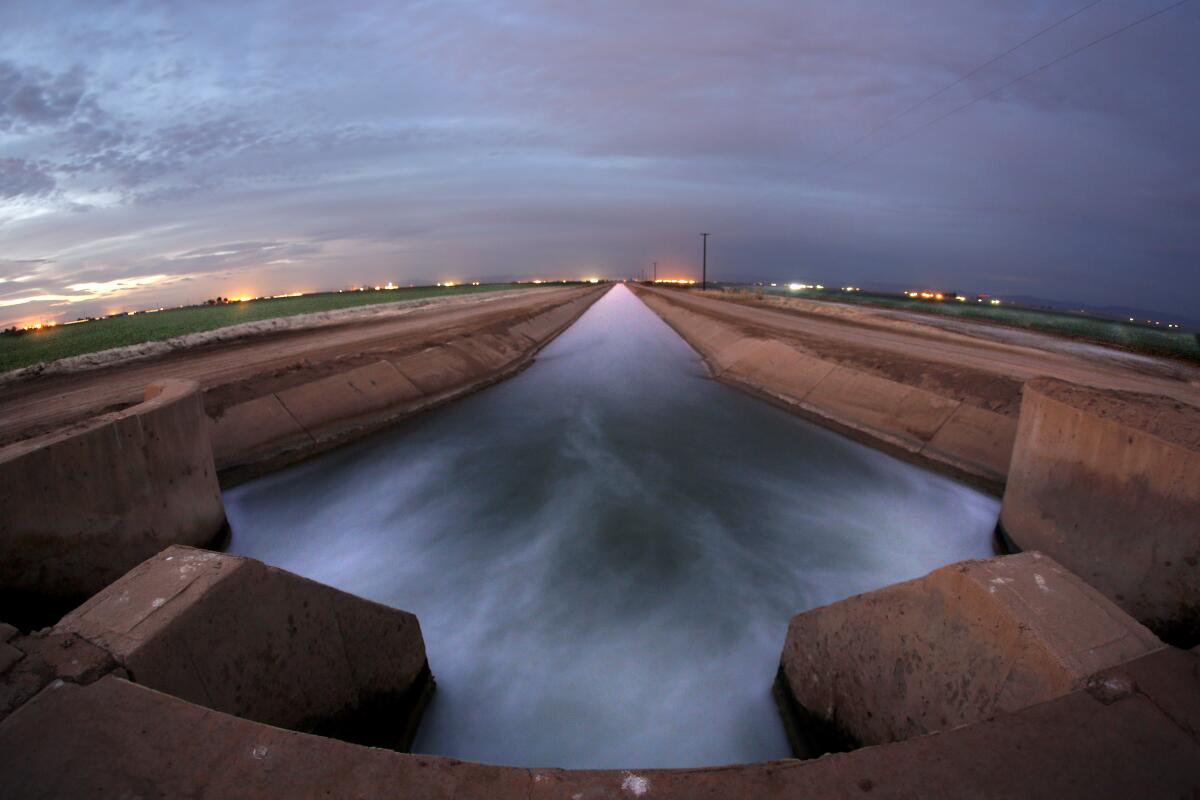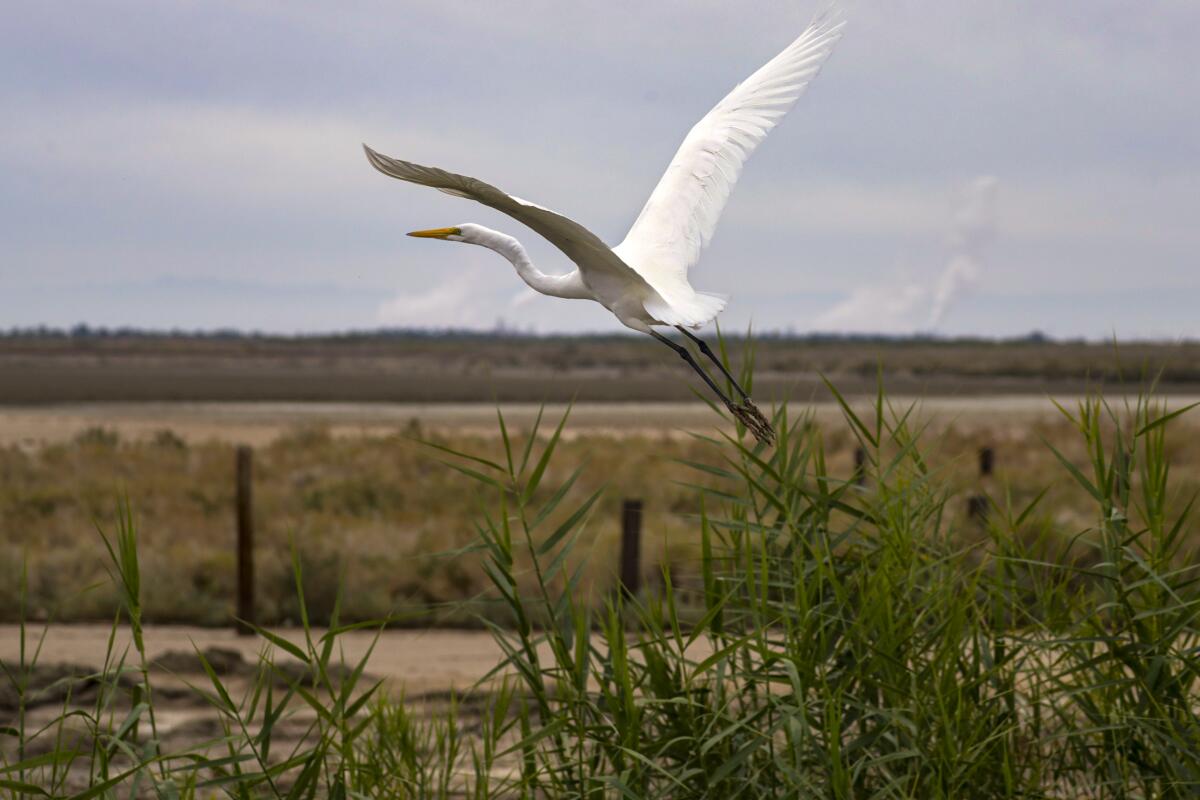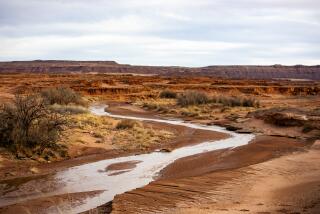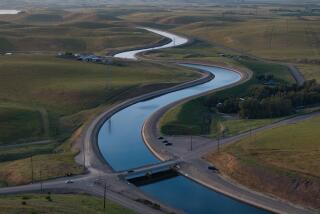A bitter dispute ends as California water agencies pledge cooperation on Colorado River

Two years ago, a pact to safeguard the West’s shrinking water supplies took effect at a ceremony high above the Colorado River.
On a terrace overlooking Hoover Dam, water officials from seven states that rely on the river had gathered to sign a deal in hopes of preventing reservoirs from falling to critically low levels.
The audience that broke into applause included officials from major water districts across the West that supply water to Denver, Phoenix and Los Angeles. But notably absent from the May 2019 ceremony were representatives of California’s Imperial Irrigation District, the single largest user of Colorado River water.
Managers of the agricultural irrigation district in the Imperial Valley had been locked in a heated dispute with the state’s other water behemoth, the Metropolitan Water District of Southern California, and were suing to challenge the deal.
Now, more than two years later, conditions have grown increasingly dire. As the Colorado River’s largest reservoirs sit at their lowest levels on record, and as an unrelenting drought intensified by climate change continues to ravage the West, water managers across the region have acknowledged that greater cooperation and larger steps are needed to prevent the reservoirs from bottoming out.
To that end, the Imperial Irrigation District announced last week that it has agreed to settle its dispute with the MWD — a major shift that means California’s two largest users of the Colorado River will once again be able to work together on ways of taking less water from the river in an effort to address the crisis.
“I think going forward we can basically think more cooperatively as we figure out different solutions or options,” IID General Manager Henry Martinez said. Settling the dispute, he said, opens a door for more “creative discussion with Metropolitan.”
The Imperial Irrigation District had filed the first of two lawsuits against the MWD in April 2019, asking a state court to block a set of agreements called the Drought Contingency Plan. Under the plan, California, Nevada and Arizona agreed to share in water cutbacks to reduce the risks of reservoirs declining to dangerously low levels.
The district’s officials had pushed for making the problems of the shrinking Salton Sea part of the deal, and in their lawsuit called for more analysis of the environmental impacts of the agreement. They had also been pressing for funds from the federal government to help the deteriorating condition of the Salton Sea, where growing stretches of dry lakebed have sent toxic dust billowing into surrounding towns, contributing to high rates of asthma.
In the end, the drought deal that emerged after negotiations didn’t include funding for Salton Sea projects, and members of the IID board decided not to participate in the agreement.
Officials of the MWD and other districts went ahead on their own, approving the agreement without Imperial. When they signed the deal in May 2019, they agreed to shoulder California’s share of potential water cutbacks.
A judge later ruled in favor of the MWD, and an appeal was pending when the two agencies agreed to settle the cases.
By ending the dispute, the Imperial Irrigation District is rejoining other California districts in agreeing to take part in possible water cuts, though its share would be smaller than had originally been discussed during the negotiations a few years ago.
Under the settlement, which was signed this month, the IID will join other agencies in leaving some water in Lake Mead if the reservoir’s level continues falling and reaches a trigger point for California to begin participating. Water deliveries are already being reduced to Arizona, Nevada and Mexico.

The Metropolitan Water District also pledged to support using federal funds at the Salton Sea to help expand the state’s program of building wetlands, restoring habitat and controlling dust along the retreating shorelines.
The Imperial Irrigation District delivers water to farmlands that grow much of the nation’s vegetables in the winter and also produce hay and other crops.
The Salton Sea has long been sustained by water that drains from farm fields in the Imperial Valley, and its decline has accelerated with the implementation of agreements in which the IID is transferring water to urban areas in Southern California. Its ecosystem is also changing as the lake grows saltier with evaporation, and populations of once-numerous birds such as pelicans and double-crested cormorants have plummeted.
For years, Imperial’s officials have pressed for the state to speed up long-delayed projects to build wetlands along the exposed shores of the Salton Sea, warning that windblown dust poses a health hazard in towns with predominantly Latino populations where many people do farm work.
For communities in the Imperial Valley, the Salton Sea “remains a top priority and one that should not be ignored,” said Antonio Ortega, an IID spokesperson. “The Salton Sea continues to pose serious environmental and public health challenges that will impact wildlife as well as communities across Southern California.”
The two water districts have agreed to “coordinate advocacy efforts to help secure additional state and federal funding to construct much-needed restoration projects at the Salton Sea,” Ortega said.
There have long been tensions between the two districts, but they’ve also had a productive relationship in collaborating on water management and conservation, said John Fleck, director of the University of New Mexico’s water resources program.
Fleck said he was saddened when Imperial didn’t sign on to the Drought Contingency Plan, often called the DCP, because he thought the district had a legitimate beef — not with Metropolitan, but with the state of California.
“Imperial made commitments back in the early 2000s to come up with a plan that would involve using less water,” Fleck said. “And in return, the state of California, so the state leadership, promised to take action to deal with the problems of the Salton Sea. And Imperial kept up its side of the bargain, and the state hasn’t.”
Fleck said the IID officials understandably felt that by conditioning their support on pulling the Salton Sea issue into the deal, “they felt it was the only leverage they had to try to get some concessions.”
When the MWD then agreed to shoulder much of the cuts without the IID, that “took away the political leverage that the IID thought it had — to use the need for a DCP to get more concessions from the state of California and the federal government to deal with Salton Sea issues,” Fleck said. In the end, the result was having one of the major water users on the river left out of the process.
“I think it’s really important that the largest water user in the basin be in the fold, be part of the discussion going forward on solving Colorado River problems,” Fleck said. “The problems of the Colorado River Basin are only going to get harder, and having the major parties collaborating in pursuit of solutions rather than in conflict is enormously important in our ability to solve these problems.”
Under the settlement, Imperial will gain the ability to store some additional water in Lake Mead. The IID officials also agreed to drop a 2020 lawsuit in which they had accused the MWD of violating an agreement by diverting and using some of their water.
This dispute arose from the details of the Drought Contingency Plan regarding how agencies were supposed to handle water stored in the reservoir.
“When we had negotiated the agreements, part of the agreements gave IID extra storage in Lake Mead, because as part of the DCP, everyone got extra storage,” said Bill Hasencamp, the MWD’s manager of Colorado River resources.
The complications began when negotiations on the deal went longer than originally planned, pushing the signing from 2018 to 2019.
“So we negotiated a separate bridge agreement with IID that said, since we have extra space in our storage account, we’ll hold your water for a year and then put it into your Lake Mead account when the DCP is approved,” Hasencamp said. “And because they didn’t approve the DCP, that agreement didn’t get approved, and so we didn’t store water for them as they had hoped. We made it clear it was a package. They felt that no, you should have still stored the water for us regardless.”
The MWD received the water because it was considered “unused water” under the terms of a previous agreement, Hasencamp said. Now, with the dispute settled, he added, “we are splitting the water and giving IID 60% back and we’re keeping 40%. So we’re splitting the disagreement.”
The MWD, headquartered in Los Angeles, supplies water to cities and water districts that serve about 19 million people across Southern California.
With the wrangling behind them, managers of the two agencies said they will resume working together on plans for dealing with the increasingly dire situation on the Colorado River.
“Seven states, two nations, several Native American tribes, countless cities and farms — all rely on the Colorado River’s waters,” said Adel Hagekhalil, the MWD’s general manager. “And yet the current level of reliance is not sustainable. Only by working together can we bring this river into balance.”
The river has long been chronically overallocated under the 1922 Colorado River Compact and subsequent agreements, and the long drought has only worsened the supply-demand mismatch. Much of the river’s delta in Mexico dried up decades ago, leaving only patches of natural wetlands.
The 2019 drought deal included two separate agreements: one for the Upper Basin states of Colorado, Wyoming, Utah and New Mexico, and another for the Lower Basin states of California, Arizona and Nevada.
Since the deal was signed at Hoover Dam, the last two years have brought fierce heat and dryness that have intensified the two-decade drought in the Southwest. Scientific research has shown that the Colorado River is sensitive to warming and that rising temperatures unleashed by the burning of fossil fuels are making the drought more severe, contributing to the declines in the river’s flow.
The water level in Lake Mead has been declining dramatically and is forecast to continue dropping. The reservoir near Las Vegas, the largest in the country, now sits at just 34% of its full capacity, the lowest level since it was filled in the 1930s after the construction of Hoover Dam.
Lake Powell, the nation’s second-largest reservoir, has also fallen to its lowest levels since it was filled in the 1960s.
The federal Bureau of Reclamation has released new projections showing worsening risks of Lake Powell and Lake Mead dropping to critically low levels. The agency’s projections show a one-in-three chance of Powell declining so low by 2023 that Glen Canyon Dam would no longer generate electricity.
At Lake Mead, the estimates show a nearly one-in-four chance of the water level dropping below an elevation of 1,025 feet in 2023, a severe shortage level that would bring major water cutbacks across the Southwest. The odds of such a such a shortage, according to the projections, rise to 66% by 2025.
The water in Lake Mead now laps against the shore at 1,067 feet above sea level, just 22 feet above a threshold at which California water districts would begin taking cuts.
With these rapid declines unfolding, water management officials have acknowledged that the existing drought agreement appears insufficient and that additional steps will be needed.
The settlement clears the way for Imperial Irrigation District officials to more freely discuss options with counterparts from the MWD and other water agencies in California. The IID is also likely to play a central role in the next round of negotiations as representatives of the states work to develop new rules for managing shortages after 2026, when the existing rules are set to expire.
“Since IID has a right to about 40% of the Lower Basin’s water, they have to be a part of the solution,” Hasencamp said. “We had figured out a way that we could move on temporarily without them. But it’ll be better with them.”







